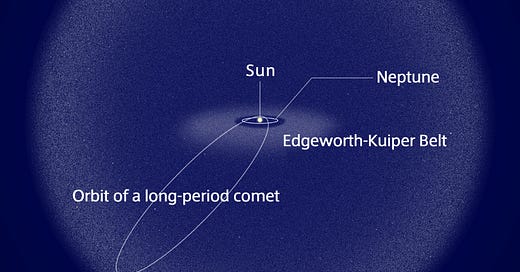It’s time to talk about the Oort Cloud.
Something is coming.
The Oort Cloud is an entirely theoretical sphere of comets and icy rocks surrounding the solar system. It was theorized to explain the orbits of comets, and why they come into the solar system at all kinds of odd angles (as opposed to the flat plane all the local planets and moons lie in). Planets and planetesimals (planets made up of tiny rocks accumulating over time) and even brown dwarf stars are rumored to lurk there as well. If you listen to late night conspiracy radio shows (a favorite insomnious pastime of mine) and hear them talk about the imminent arrival of Planet X or Nibiru: they’re planets alleged to live in the Oort Cloud (the source for this is—and I am not making this up—extraterrestrials from the Zeta Reticuli star system).
I say “entirely theoretical,” but the Oort Cloud became less theoretical a few weeks ago, when they discovered something big and weird and very old coming toward the inner solar system. It’s called Comet Bernardinelli-Bernstein, and it’s coming in at a 90 degree angle, almost perpendicular to the plane of the solar system. They tracked the orbit from 2014 to 2018, and concluded that a) the far point of the orbit is definitely inside the Oort Cloud, and b) the near point of the orbit is just outside Saturn’s orbit. The thing is about 100 miles wide. It’s just outside of Neptune’s orbit now. It’s made of ice and rock. It’ll reach its closest point to us in about 10 years, January of 2031.
It’s not going to hit us. Beyond that, not much is known. Comets are notoriously unpredictable, and the orbit will certainly change upon encountering the gravitational pull of other planets. It’s already forming a tail. That tail might grow and the comet might become a blazing wonder in the night sky. Or, more likely, the comet might fizzle, as so many comets do, and become a minor footnote, a fuzzy dot of light that can be seen with a very dark sky and an amateur telescope (I’ll be watching regardless).
Most of the stuff floating around the Oort Cloud has incredibly stable orbits, negotiated over billions of years, so that few objects stray out of it. What causes an object to leave the Oort Cloud? Collisions and close fly-bys. So, at some point in time, either one object collided with another, or something large enough to shift the gravity of a 100 mile wide object slid silently by (the operating theory of those extraterrestrials from the Zeta Reticuli).
Which leads me, five paragraphs later, with this metaphor: something momentous happened a long time ago. A collision or a close encounter with another object. And though it happened literal eons ago, the consequences of that meeting are only now becoming known. We don’t know much. But our future is on its way, mostly wrapped in uncertainty, and we’re going to have 10 years to watch it come into focus. It’s like a child from a one-night stand, ten years ago, coming back home to knock on your front door.
Who will you be in ten years? What will the world look like? If a giant comet graces our skies, will our increasingly fractious society take it as a sign? Will it be seen as a harbinger of doom, or a promise of peace? Or will it be seen for what it actually is: a tiny fragment from the solar system’s ancient past, flying close enough to reveal a few of its mysteries, before turning around and heading back into the black unknown of the Oort Cloud.
I’ll leave you with this choice quote from today’s NY Times: “Comets are like cats. You never know what they are going to do.” - Meg Schwamb, astronomer at Queens University, Belfast.
Peace.
Time for commerce. July’s story will be the best story I wrote in 2020, to be published by Black Moon Digest next month. Stay tuned!
May’s story: Nine Lives
April’s story: Prince Albert in a Can
March’s story: Fuck, Marry, Kill
February’s story: Veronica Scissors
My first novel, Life Under Water
My website: jeffmwood.com.
My Amazon page.
My erotic flash fiction series, Serious Moonlight (as J G Cain)




